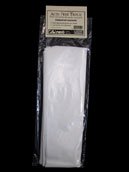- Features
- Description
- Similar Items
Protects the surface of non-hardend black & white prints
Prevents contact with the back of the top print
Allows the print to be handled without touching the emulsion side
Use to line the bottom and top of archival boxes to prevent dust entry
Totally Archival
Prevents contact with the back of the top print
Allows the print to be handled without touching the emulsion side
Use to line the bottom and top of archival boxes to prevent dust entry
Totally Archival
Binding:
KitchenBrand:
LinecoEAN:
0099295531900Label:
LinecoManufacturer:
LinecoModel:
741-3041Size:
30x40Warranty:
Excellent for stuffing, interleaving or a variety of uses, this translucent tissue is completely acid-free and has a thickness of .001. It has countless applications in museums, archives or libraries. Its very soft surface makes it an ideal choice for separation wrapping. This non-buffered tissue is recommended for use with colored prints, textiles and watercolors. It can be used with all forms of artwork as well. Albumen, cyanotype, dry transfer or chromogenic prints also require unbuffered tissue. Very thin (.001) 16 gm2 tissue for maximum translucency. This tissue is an excellent choice for separating prints, drawings or lithographs. Price per package of 12 sheets. Buffered vs. Unbuffered Calcium carbonate (chalk) is often added to paper pulp during the paper making process as a buffering agent. This buffering agent raises the pH level of the paper to the alkaline side of the scale. The addition of 3% calcium carbonate provides a pH of approximately 8.5 in paper, making it non-acidic. The reservoir of calcium carbonate also helps neutralize other acids in the environment that would normally make any paper become acidic over time. Because of its ability to neutralize acids and extend the life of paper and paperboard, buffering is more often than not a benefit in storage boxes, folders, and other paper enclosures. There are, however, some exceptions. At one time, it was believed that photographs stored in buffered enclosures might be adversely affected by buffering. This is no longer believed to be true except for a couple of specific types of photographs. With dye transfer prints and cyanotypes, non-buffered enclosures should be used. The image substance of both these print types can be harmed by alkalinity. For most other kinds of photographs, including black and white prints, color prints, and albumen prints, either buffered or unbuffered enclosures are satisfactory. The other concern over buffering comes from the inclusion of protein based materials in buffered enclosures. It is generally believed that materials that come from animals should be stored in unbuffered enclosures - or at least should not come in contact with buffered materials. These items include silk, wool, leather, feathers, animal specimens, horsehair, etc. Everything else, especially in the collectibles arena, would benefit from storage in a buffered enclosure. This is especially true for all paper items.






